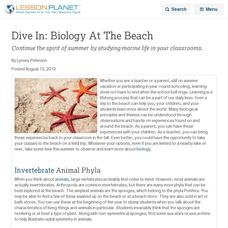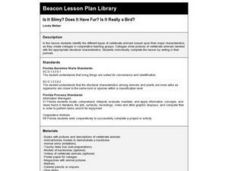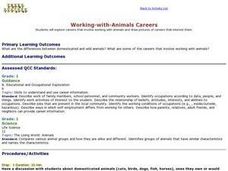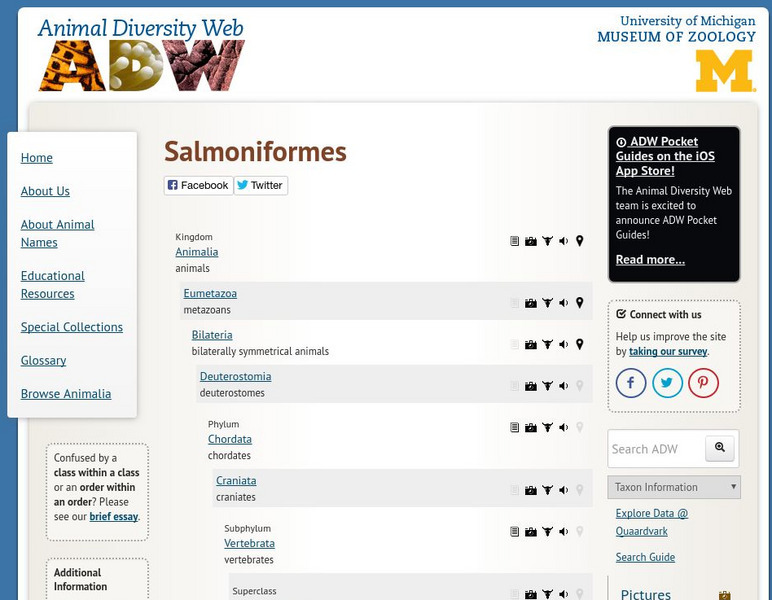Curated OER
Identifying Vertebrates
In this biology worksheet, students look for the answers to how to classify animals. They specifically focus upon the vertebrates while differentiating the characteristics from other organisms.
Curated OER
Plant Life Cycles
Follow the life cycle of a dandelion with a lab sheet for kindergartners. They learn about the order of events in a dandelion's life, then put the stages of life in order. Can they describe the life cycle of a pumpkin? For extra...
Curated OER
Dive In: Biology At The Beach
Continue the spirit of summer by studying marine life in your classrooms.
Curated OER
What's A Mammal?
Students examine mammals understanding what a mammal is and reviewing the eleven mammal groups. In this science lesson, students play a game known as Mystery Mammal Game. Yet, first students research about the mammal and then give...
Curated OER
Comma Worksheet 2
In this grammar worksheet, students insert all necessary commas in fourteen sentences. Students check to make sure that each sentence is grammatically correct.
Curated OER
Observing Brine Shrimp
Students observe brine shrimp eggs, create an appropriate environment for their survival, and observe their growth.
Curated OER
Introduction to Animals
The details about invertebrates and invertebrates give valuable information about the characteristics of multicellular organisms. Examples of nutrition styles and symmetry are interesting. Also, these slides are clear in presenting a...
Curated OER
Is It Slimy? Does It Have Fur? Is It Really a Bird?
Sixth graders identify the different types of vertebrate animals based upon their major characteristics, as they create collages in groups. Collages show pictures of vertebrate animals labeled with the appropriate structural...
Curated OER
Wildlife Habitat
Students explain what a habitat is and describe its four elements. They see how an area's habitat suitability varies with different species of wildlife. They name factors that affect habitat suitability.
Curated OER
Investigating Animals in Water
Students observe small animal activity. They identify local water animals and describe the habitats where water animals can be found. Students collect samples to observe in the classroom.
Curated OER
Working-with-Animals Careers
First graders list and discuss careers that involve working with animals and draw pictures of careers that interest them. They compare and contrast domestic and wild animals.
Curated OER
Sharkland Wiki
Students, while researching the waters around southern Africa and viewing a video of the episode "Sharkland" from Thirteen's series NATURE, critique reliability of online resources and analyze the various components of a wiki. They...
Curated OER
All/The - class: making generalizations about the group
In this generalizations worksheet, students change the form of the sentences to take the subject and change it into a group generalization. Students complete 8 sentences.
Curated OER
Goals of the Diversity of Life Unit
Students are introduced to the unit on the importance of diversity of life and the role that interdependence plays in our worlds. this is part of a multi-lesson unit on the diversity of life.
Natural History Museum
Natural History Museum: Reptiles, Amphibians and Fishes
This online exhibit from the Natural History Museum branches out in many fields to cover the broad topics of reptiles, amphibians and fishes. Thirteen subtopics are provided including several videos and informative articles.
Yale University
Yale New Haven Teachers Institute: Animal Kingdom
Background information about all of the classes of the animal kingdom, followed by four short lesson plan outlines.
Sea World Parks & Entertainment
Sea World: Animal Information Database
Sea World's site featuring a variety of information about their animals, as well as general animal information. Includes "Animal Bytes," a list of animals with some of their characteristics. Also includes some games and teacher resources.
Extreme Science
Extreme Science: World Records of the Animal Kingdom
What is the oldest living creature? What is the fastest animal on land? What is the biggest bug? Find that answer to these question and more with this fun and interesting resource.
CK-12 Foundation
Ck 12: Third Grade Science: Life Sci: Animal Characteristics and Classification
[Free Registration/Login may be required to access all resource tools.] Presents an overview of the major animals groups (mammals, birds, reptiles, amphibians, fish, arthropods, vertebrates, invertebrates, those having live births and...
Quia
Quia: Animal Facts Scavenger Hunt
At this website you are given ten questions to answer and links to three websites where you can find those answers.
US Fish and Wildlife Service
U.s. Fish and Wildlife Service: Listed Species Believed to or Known to Occur in Each State
This page was created for quick access to pages that offer the most recent fact sheets, life history, and regulatory information for different animal species. Choose a state in the list to find a listing of animal species, and follow...
ClassFlow
Class Flow: Animal Classification
[Free Registration/Login Required] Students will classify organisms into groups and relate how they determined the groups with how and why scientists use classification. They will also demonstrate how animals are sorted into groups...
Regents of the University of Michigan
Animal Diversity Web: Salmoniformes
A brief overview of the Salmoniformes Order of fish. These fish are very important to humans economically. Many of them are pictured in the photos on this site.
Wonderville Media
Wonderville: Fish
You cannot "pet" a fish, but it is good company. You can watch it swim and play. You can talk to it, even if it won't talk back. Some fish react to a friendly voice or face! There are many kinds of fish. No matter what kind you have,...























